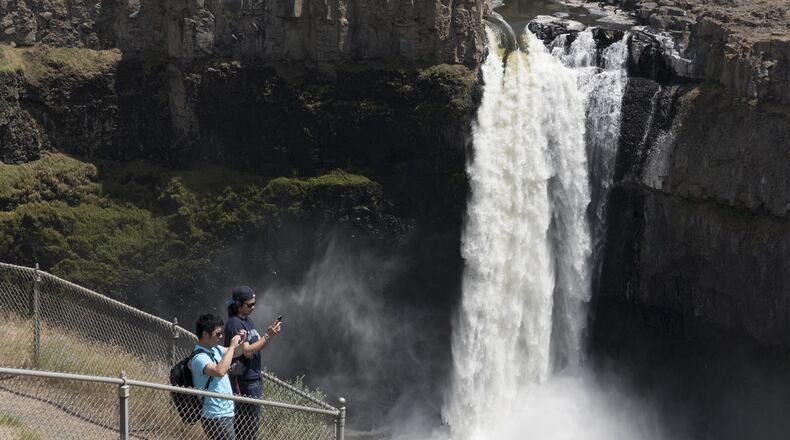Want to hike five Washington volcanoes in five days? Go for it. Feel like paddling the length of the Spokane River? No one is stopping you. Developing new, and dangerous, ice climbing routes deep in the Montana back country? Far from help, should anything go wrong?
It’s your choice.
Sure, it’s risky. But managing that risk is up to you. Or at least that’s how it’s long been.
That ethos may be changing in the face of increased litigation and a surge in outdoor recreation.
Each year the number of hikers, climbers and boaters increases. And with increased use often comes increased risk.
For example: the Mountaineers, based in Seattle, have an annual wait list of 200 people for an introductory mountaineering class.
In 2015, a woman sued the federal government after her husband was gored to death by a goat in Olympic National Park. And while the court dismissed her case, several of the judges noted that it may be time to set new precedent that would allow cases like hers to move forward.
Officials in Colorado blamed a 2017 spike in deaths on social media, saying many were heading into the back country ill-prepared.
And in France, the mayor of a town near Mont Blanc, a notoriously dangerous mountain, ordered that anyone climbing must bring a harness, rope and headlamp. Those that choose to tackle the mountain without that gear can be fined. Solo climbing on Mt. Everest was banned earlier this year. The list goes on.
These changes have happened over decades. And many have raised the alarm worrying about the gradual urbanization of the wild.
Recently in a New York Times opinion article Francis Sanzaro, the editor of Rock and Ice and Ascent magazines, decried this shift in philosophy and management.
“If we make the mountains safe, perceive them as urban space and demand to have them as regulated as city blocks, we have not only lost ‘the mountains’ but that part of us only they can foster,” he wrote in the article, titled “Keep our mountains free. And dangerous.”
These same arguments and concerns have appeared in the aftermath of the Palouse Falls drowning death and the subsequent article in the Spokesman Review about Dorothy Prophet, a mother whose son died a year ago at the iconic attraction.
Prophet has been advocating for better signage, something she believes could save lives.
“I’m just so upset that all of the efforts that I’ve made in the past year didn’t bear any results,” she said.
She’s petitioning Washington State Parks to install more warning signs around the popular and illegal trails that skirt the cliff edge and descend toward the water itself.
She told her story to my colleague Jonathan Glover.
The online comments were swift and predictable.
“If you can’t figure out the edge of a cliff is dangerous, I don’t think more signs will help,” wrote one person.
Another added, “We need less morons. Not more safety.”
Someone else chimed in: “Please. Anyone that’s been there knows it’s dangerous by its nature. It needs no more signage.”
These comments, and the sentiment they represent, miss the point. While I agree that nature should not be regulated into passivity, Palouse Falls is a different beast altogether.
In fact, despite what some might say in their online comments, Dorothy Prophet is not advocating a nanny-state sensibility.
“I don’t think the parks should be closed,” she said. “I don’t think that access should be blocked to those who know what they are doing and properly attired.”
Instead, she believes that the nature of Palouse Falls fundamentally requires more regulation. As an iconic, easily accessible natural wonder, it attracts all types. Many who have none, or little, outdoor experience and don’t know the basics.
Prophet recently spent a weekend at the falls, sitting near the area where her son fell to his death. What she saw reaffirmed her conviction.
“I swear to you I saw people walking on those trails in flip flops,” Prophet said. “That is so inappropriate.”
So, she believes there should be more and better signage. Maybe a fence or two.
A spokesperson for the park’s department said there are signs warning people to stay on official trails. But there aren’t signs along those unofficial trails or near the cliff edge.
Yet, it’s undeniable that many who go to Palouse Falls hike near the edge of the cliffs, or venture down to the water’s edge.
For those experienced with climbing, hiking and swimming the risks may seem self-evident.
But for someone who knows only that Palouse Falls is the state’s official waterfall and a good spot to get braggadocious Instagram photos, there is likely a false sense of security.
Prophet’s suggestions don’t fundamentally endanger our freedom. Her suggestions aren’t the first slippery step toward big government regulated recreation.
Really, what she’s asking for is better education.
Putting more signs up, or even fences, certainly won’t stop someone from climbing to the edge. But, perhaps, it will give someone pause.
And, that’s a pause that could save a life.
About the Author
